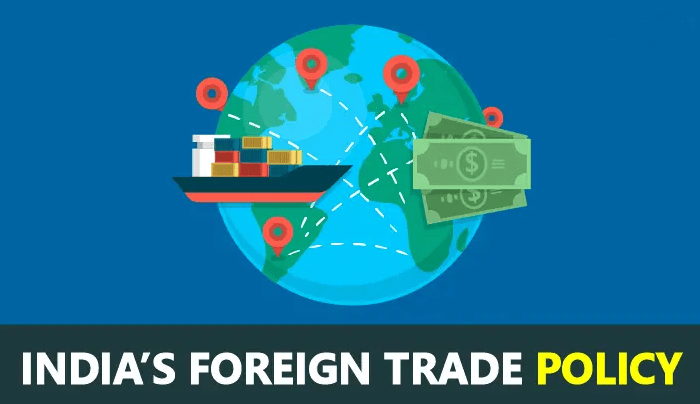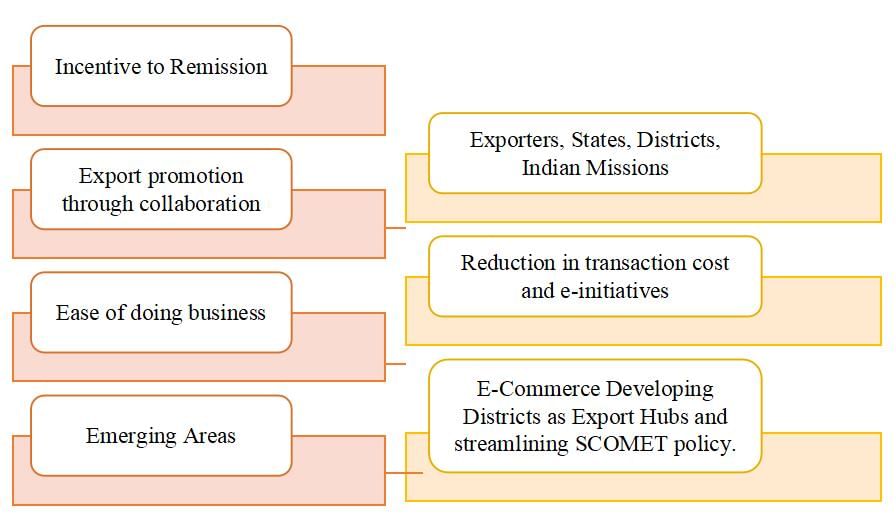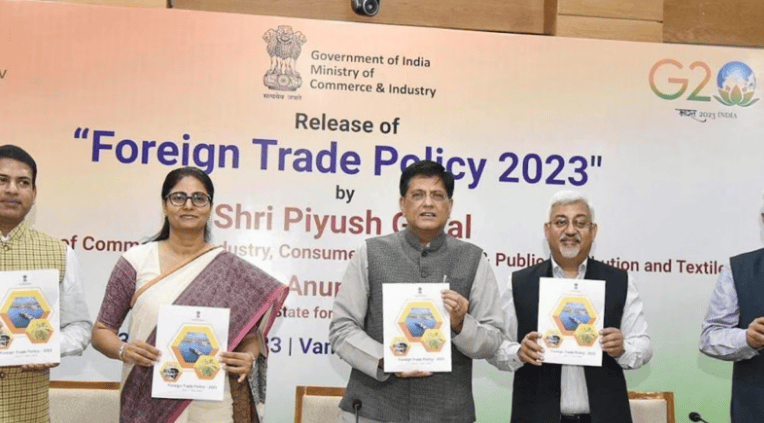India's Foreign Trade Policy | Crash Course for UGC NET Commerce PDF Download
| Table of contents |

|
| Introduction to India's Foreign Trade Policy |

|
| Features of India's Foreign Trade Policy |

|
| Changes in India's Foreign Trade Policy |

|
| India’s Recent Foreign Trade Policy |

|
Introduction to India's Foreign Trade Policy

India's Foreign Trade Policy (FTP) is a crucial framework for guiding the country's external trade activities. Managed by the Directorate General of Foreign Trade (DGFT), the FTP aims to enhance exports, foster a supportive trading environment, and drive sustainable economic growth. This policy serves as a key component of India's economic strategy, shaping its trade interactions with other nations. Let’s explore the main aspects of India's Foreign Trade Policy.
Objectives of the Foreign Trade Policy
Promote Exports: The primary goal is to increase India's exports of goods and services to global markets, thereby boosting foreign exchange earnings.
Create Jobs: By enhancing export activities, the policy aims to generate employment opportunities within the country, particularly in export-focused sectors.
Stimulate Industrial Growth: The policy seeks to promote industrial development, especially for small and medium-sized enterprises (SMEs) that are labor-intensive and create employment.
Diversify Export Basket: The FTP encourages a broader range of export products and services, reducing dependency on a few major exports.
Enhance Competitiveness: Through various incentives and subsidies, the policy helps domestic firms improve their competitiveness and production efficiency in the global market.
Increase Foreign Exchange Earnings: By achieving higher export growth, the policy aims to enhance foreign exchange earnings, which support imports and overall economic development.
Encourage Technological Advancement: The policy promotes the adoption of new technologies and innovations to make Indian exports more competitive on the global stage.
Features of India's Foreign Trade Policy

Exchange of Goods and Services: Foreign trade involves the trading of goods and services between countries, where one nation exports to another and imports in return.
Use of Multiple Currencies: Different nations use different currencies, requiring foreign trade to involve currency exchanges for payments and settlements. Exchange rates play a significant role in this process.
Cross-Border Movement: Goods and services must physically cross international borders for foreign trade to occur, moving from the exporting country to the importing country.
Regulated by Trade Policies: Foreign trade is governed by the trade policies and agreements of various nations, which define export and import regulations, taxes, and duties.
Effective Resource Utilization: Foreign trade allows countries to access resources and goods they lack but others possess, promoting more efficient use of global resources.
Boosts Competition: Exposure to global competition through foreign trade encourages domestic firms to improve quality, efficiency, and innovation, benefiting consumers.
Economic Interdependence: Frequent trade between nations fosters economic interdependence, creating mutual interests in maintaining positive trade relations.
Balance of Trade and Payments: Foreign trade affects the balance of trade (exports vs. imports) and the balance of payments (cross-border monetary flows), with governments striving to achieve a favorable balance.
Impact of Foreign Trade Policy on the Indian Economy
The Foreign Trade Policy (FTP) significantly influences the Indian economy in several ways:
Boosts Exports: The primary aim of the FTP is to enhance Indian exports. Increased exports lead to higher foreign exchange earnings, job creation, and industrial growth, positively impacting the economy.
Generates Employment: By incentivizing exports, the FTP helps create job opportunities, especially in small and labor-intensive sectors, which contributes to reducing unemployment.
Improves Balance of Payments: As exports grow faster than imports due to the FTP, it strengthens India's current account and balance of payments, thus enhancing economic stability.
Attracts Foreign Direct Investment (FDI): A proactive FTP can attract more FDI as global investors seek opportunities in India’s expanding export sectors, further boosting the economy.
Sector-Specific Benefits: The FTP supports key sectors like textiles, pharmaceuticals, IT, and automobiles, promoting their growth through targeted incentives and subsidies.
Drives Innovation and Technology: The policy encourages technological advancements and innovation, making Indian exports more competitive and benefiting the economy in the long term.
Enhances Competitiveness: By providing subsidies and incentives, the FTP helps Indian firms reduce costs and improve their global competitiveness.
Fosters Economic Growth: Combined effects of increased exports, job creation, investments, and enhanced competitiveness contribute to the overall growth of the Indian economy over the medium to long term.
Changes in India's Foreign Trade Policy
Recent changes in India's Foreign Trade Policy include:
Shift to Services Exports: There is now a stronger focus on boosting services exports, such as IT, BPO, tourism, and healthcare, in addition to traditional merchandise exports.
Emphasis on 'Make in India': The policy promotes import substitution and domestic value addition through the 'Make in India' initiative to reduce reliance on imports.
Ease of Doing Business Reforms: Several reforms have been introduced to simplify and automate export-import procedures, making it easier for businesses to operate.
Infrastructure Development: There is increased focus on developing trade-related infrastructure, including ports, roads, and railways, to enhance India’s export competitiveness.
Encouraging MSME Exports: The policy emphasizes supporting micro, small, and medium enterprises (MSMEs) with various schemes aimed at boosting their exports.
Diversification of Export Basket: Efforts are being made to expand India’s export basket beyond traditional sectors like textiles and gems, promoting new sectors.
Promotion of R&D and Innovation: There is a greater emphasis on research and development, innovation, and technology adoption to accelerate export growth.
Liberalization of Foreign Investment Policies: Foreign direct investment (FDI) policies have been relaxed in several sectors to attract more investments and technology to enhance exports.
India’s Recent Foreign Trade Policy

Reducing Imports and Boosting Self-Reliance: The FTP focuses on reducing import dependence and enhancing domestic manufacturing under the Atma Nirbhar Bharat initiative.
Incentives for Manufacturing and Exports: New incentives and subsidies are provided to manufacturers and exporters to boost competitiveness and export performance.
Promoting Agriculture and Fisheries Exports: The policy emphasizes increasing exports of agricultural products, fisheries, organic products, and bamboo.
Support for Labour-Intensive Sectors: Higher incentives are offered to sectors that create substantial employment, such as textiles, leather, and food processing.
Incentives for R&D and Technology: Companies investing in R&D and technology solutions receive higher export incentives.
Ease of Doing Business Measures: The policy continues to simplify export-import procedures and improve trade facilitation.
Focus on District-Level Exports: There is an effort to promote exports from all districts of India, rather than concentrating on major cities.
Logistics and Infrastructure Development: The policy emphasizes improving trade-related infrastructure, including ports, highways, and warehousing, to lower logistics costs.
Strategy of India’s Foreign Trade Policy
Incentives and Subsidies: The government provides various subsidies, incentives, and tax benefits to exporters to enhance the global competitiveness of Indian exports.
Infrastructure Development: Investments are made in trade-related infrastructure, such as ports and roads, to reduce logistics costs and boost export competitiveness.
Technology Upgradation: The policy promotes the adoption of new technologies and innovation to ensure Indian exports meet global standards.
Ease of Doing Business Reforms: Export-import procedures, documentation, and customs clearances are streamlined to facilitate easier international trade.
Focus on Labour-Intensive Sectors: The policy prioritizes promoting exports from sectors that generate significant employment, like textiles and food processing.
Diversifying Export Basket: There is an emphasis on expanding the range of export products to include electronics, pharmaceuticals, and agriculture, among others.
Promoting Services Sector: The policy also targets the growth of service exports, including IT, BPO, tourism, education, and healthcare.
Developing Global Strategic Partnerships: India seeks to establish trade agreements and strategic partnerships with key trading partners to improve market access for its exports.
Advantages of Foreign Trade Policy
Boosts Exports: By offering incentives and subsidies, the Foreign Trade Policy (FTP) aims to enhance India's exports of goods and services. This leads to increased foreign exchange earnings and job creation.
Fosters Industrial Growth: The growth in exports contributes to expanding industrial capacity and the development of the manufacturing and service sectors, driving overall economic growth.
Creates Jobs: The FTP focuses on labor-intensive sectors, which are significant job creators, thereby helping to reduce unemployment.
Enhances Balance of Payments: As exports grow faster than imports due to the FTP, it improves India's current account balance and overall balance of payments.
Promotes Technological Advancement: The policy encourages investment in research and development (R&D), innovation, and new technologies, fostering long-term technology development.
Boosts Competition and Efficiency: Exposure to global competition compels domestic industries to improve quality, efficiency, and innovation, benefiting consumers.
Supports Infrastructure Development: The FTP promotes the development of essential trade-related infrastructure, which in turn boosts exports and positively impacts the economy.
Drives Economic Growth: Increased exports, job creation, technological progress, and enhanced competition contribute to the nation’s economic growth over the long term.
Disadvantages of Foreign Trade Policy
Exposure to Global Risks: Dependence on external demand means that global economic downturns or trade tensions can negatively affect India’s export growth targets.
Increased Import Dependence: While the FTP promotes exports, it can lead to higher reliance on imports to meet domestic needs.
Competition from Cheap Imports: Open trade policies may expose domestic industries to competition from cheaper imports, potentially harming some sectors.
Job Losses in Certain Sectors: Increased imports due to trade policies may lead to the closure of domestic industries, resulting in job losses in those sectors.
Strain on Government Finances: The financial burden of providing various incentives and subsidies under the FTP can strain government budgets and limit spending on other critical areas.
Environmental and Resource Costs: The focus on export-driven economic growth can sometimes lead to environmental degradation and unsustainable resource use.
Regional Disparities: The benefits of export growth often favor major cities and business hubs, leading to uneven regional development.
Inequality: Economic gains from the FTP may disproportionately benefit large businesses, with smaller businesses and workers receiving fewer benefits.
Limitations of Indian Foreign Trade Policy
Vulnerability to Global Uncertainties: India’s export growth is heavily influenced by global economic stability and trade dynamics. Major global uncertainties can impact FTP targets.
Slow Diversification of Exports: India still needs to diversify its export basket beyond traditional sectors, making it vulnerable to fluctuations in demand for key products.
Infrastructure Challenges: Despite improvements, inefficiencies in vital infrastructure, such as ports and transportation networks, continue to increase logistics costs and hinder export competitiveness.
Limited R&D and Technology Adoption: Relatively low investment in R&D and challenges in technology adoption restrict the ability to produce high-quality, competitive export products.
Bureaucracy and Compliance Issues: Exporters face bureaucratic hurdles and complex regulatory requirements, which can impede progress despite reforms aimed at easing business operations.
Limited Integration into Global Value Chains: Indian companies have limited involvement in global production networks, restricting access to larger export markets.
Dependence on a Few Markets: India’s export focus remains concentrated in developed markets like the USA and the EU, with insufficient diversification of export destinations.
Rising Input Costs: Increasing costs for power, labor, and raw materials in India challenge export competitiveness. Incentives under the FTP may not fully offset these rising costs.
Conclusion
India’s Foreign Trade Policy is designed to enhance exports, foster trade, and stimulate economic growth. Its objectives, strategies, and incentives aim to boost export growth, create jobs, encourage industrial development, and improve competitiveness. However, the policy also faces challenges, such as vulnerability to global uncertainties, infrastructure limitations, high input costs, and uneven regional benefits. The policy’s effectiveness is influenced by these limitations and the need to address issues such as bureaucratic hurdles and dependency on a few export markets.
|
157 videos|236 docs|166 tests
|
FAQs on India's Foreign Trade Policy - Crash Course for UGC NET Commerce
| 1. What is India's Foreign Trade Policy? |  |
| 2. What are some key features of India's Foreign Trade Policy? |  |
| 3. What are some recent changes in India's Foreign Trade Policy? |  |
| 4. How does India's Foreign Trade Policy impact the economy? |  |
| 5. What are some of the challenges faced by India's Foreign Trade Policy? |  |




















